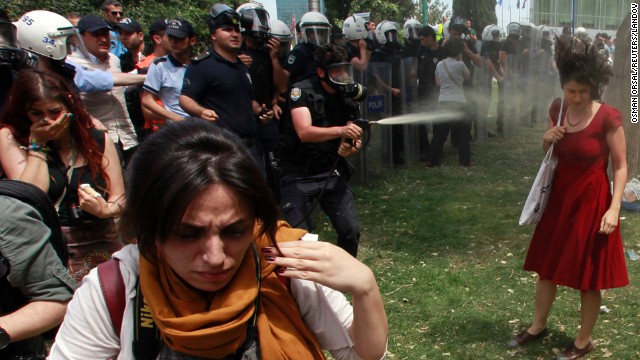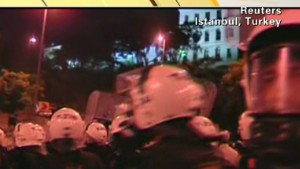Woman labeled 'icon' of Turkey protests: It's not about me
June 5, 2013 -- Updated 1536 GMT (2336 HKT)

Turkey's riot icon: Woman in red dress
Wearing a red summer
dress and a delicate necklace, the woman walked among demonstrators in
Istanbul's Taksim Square when a security officer lurched at her and
pepper-sprayed her so powerfully her hair was blown upward.
.
She could do nothing but
turn away from the toxic spray. The officer, wearing a gas mask, lunged
closer to her, unleashing more spray on the back of her neck. She
covered her mouth as officers spray others.
.
The photos of the incident have been shared widely on social media in recent days. International headlines have proclaimed her an "icon" of the movement against the government of Prime Minister Tayyip Erdogan.
 Apology for 'police aggression'
Apology for 'police aggression'
 Online campaign puts spotlight on Turkey
Online campaign puts spotlight on Turkey
 Police, protesters clash in Ankara
Police, protesters clash in Ankara
.
"That photo encapsulates the essence of this protest," a math student named Esra told Reuters. "The violence of the police against peaceful protesters, people just trying to protect themselves and what they value."
The images have also inspired cartoons and graffiti in Turkey and around the world. And just seeing a woman in a red dress walking in public has apparently touched a chord with other women in the region, too.
.
Zeinobia tweeted, "The
woman in red in Turkey, I wish to wear such dress in downtown Cairo
without fear, without protests, without sexual harassment."
But the truth is that woman in red told CNN Wednesday that she wants no part of this.
What's happening in Turkey is the "people's revolt," she said.
.
Ceyda Sungur told Turkey's TV 24 that she is uncomfortable about her new fame. She doesn't want to be an icon of a movement.
"There are a lot of
people who were at the park and they were also tear-gassed," she said.
"There is not (a) difference between them and I."
But, she added, "I am
not surprised" about the violence that evolved from what began days ago
as a peaceful sit-in to protest plans to demolish a park in central
Istanbul -- the last green space in the city center.
.
Some in the crowd chanted "Tayyip resign!"
"Shoulder to shoulder against fascism!" they shouted.
Riot police moved in,
lobbing tear gas and using pepper spray. Protesters responded by hurling
bottles, blocking bulldozers and setting up barricades. Eventually,
protesters and police were locked in full-on clashes.
Erdogan conceded Saturday that Turkish security forces had used tear gas excessively against demonstrators.
On Tuesday, a top
Turkish official apologized for the "police aggression" and trade unions
threw their weight behind the demonstrations.
The 240,000-member KESK
confederation of public-sector workers called for a two-day strike to
protest what it calls the "fascism" of Erdogan's ruling Justice and
Development Party.
.
Riot police around
Ankara's central Kizilay Square brought in armored vehicles topped with
water cannon in a show of force Tuesday evening, but the demonstrations
throughout Wednesday were mostly calm.
.
CNN's Talia Kayali contributed to this report.
